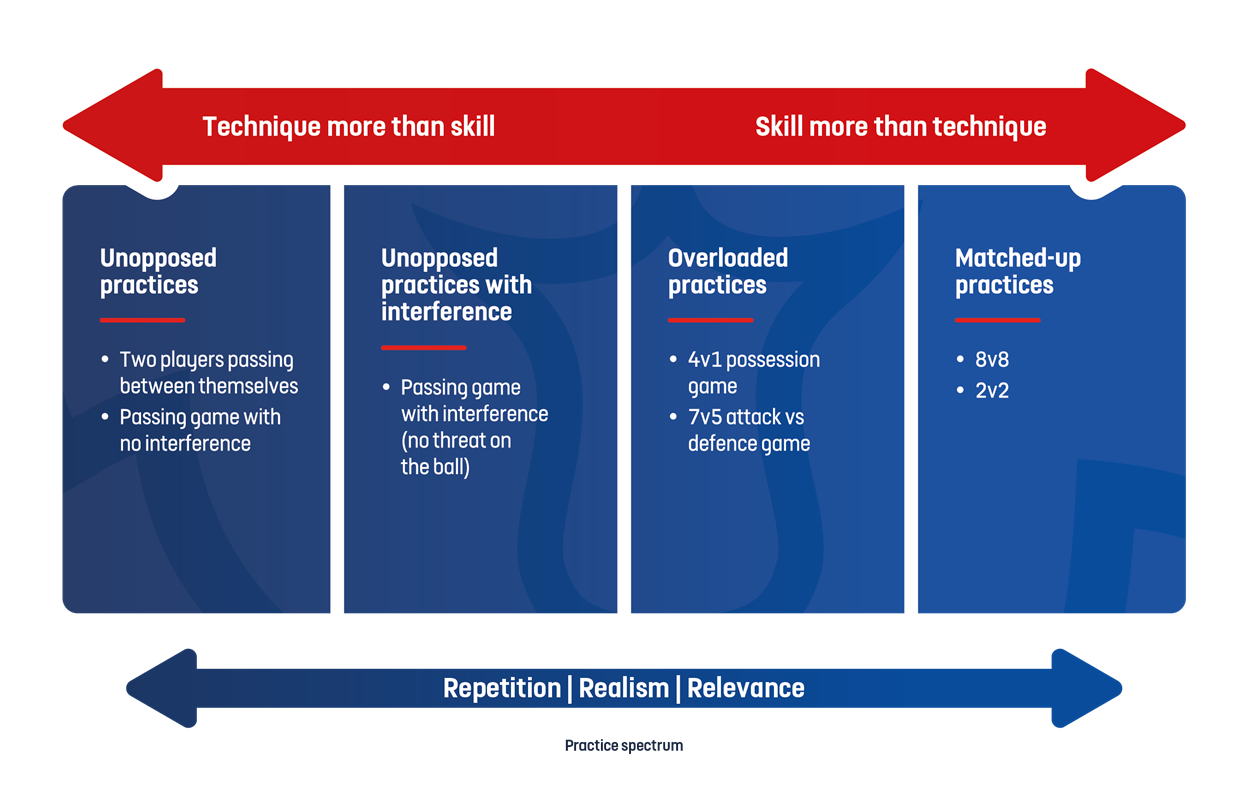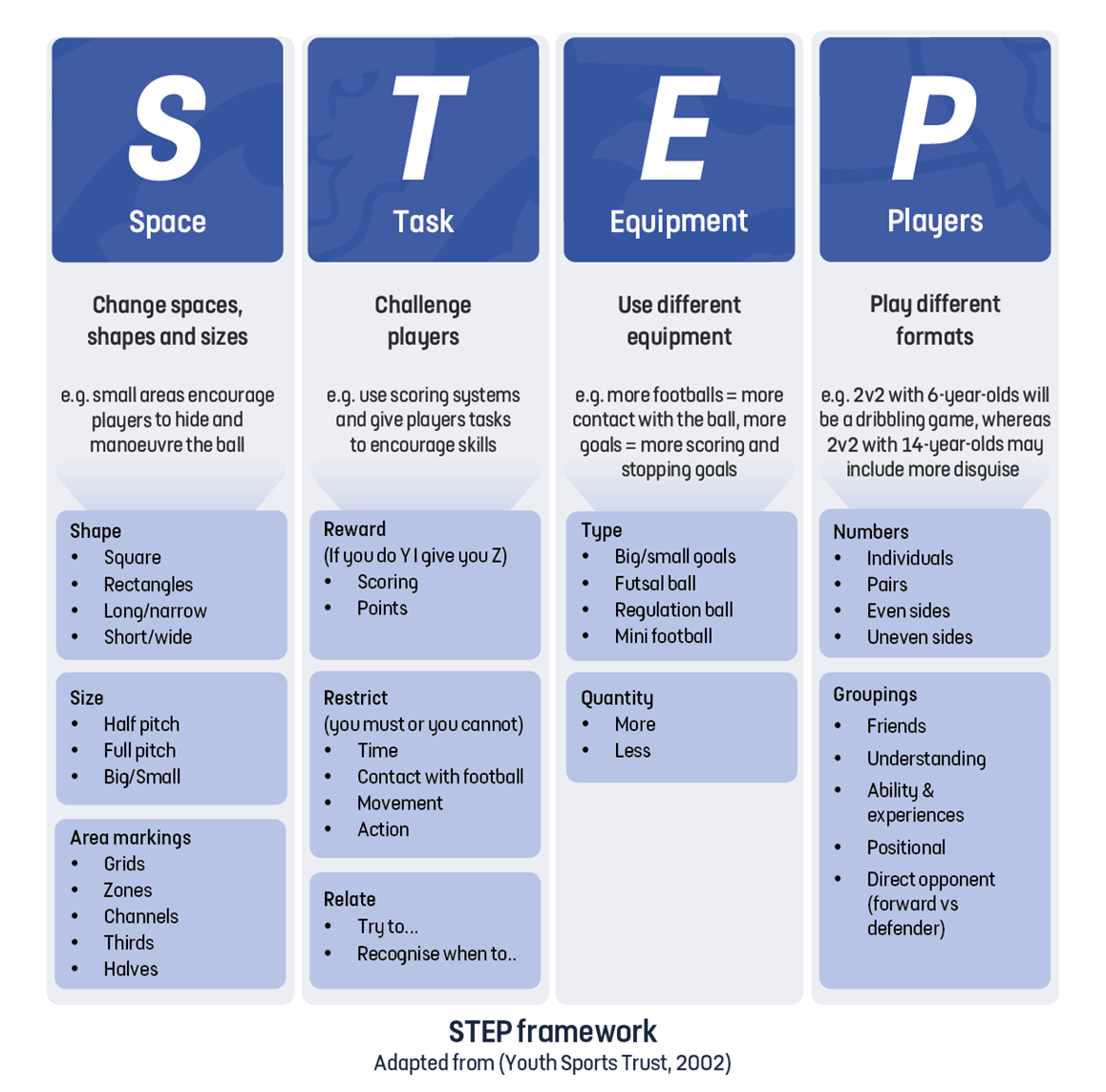If we want to provide our players with a safe and fun environment where they can also become better footballers, we must give them opportunities to learn and develop within our practices. In this blog, Katie Sorenson, Analyst and Coach, brings to life key considerations for developing practices that inspire player learning, using game insights to best prepare them for the challenges they will face on a matchday.
When designing practices for our players, it is important we consider the 3 R’s. Our sessions need to be realistic to the game and relevant to our players' age and stage. The practices should also offer repetition, to give players lots of opportunity to practice. In our last blog, Control, Cover and Be Compact: Tactics of a mid-block, we discussed the out-of-possession strategies and tactics of a mid-block – what it is, why you might use it and what success could look like. From this insight, we can understand the role a mid-block shape can play in team success, through the use of data and video to bring it to life. We can now start to piece together what a session might look like, that works on elements within the mid-block to provide support for your players. This will help them to understand their roles and responsibilities and what is then expected of them within this out of possession tactic on game day.
To ensure we are putting on the right types of sessions for our players, we need to ensure we are planning them effectively to achieve our intended session outcomes. As coaches, it is vital we have these guidelines to support us through our practices. If we know what we want to get out of the session, it can help us to put on the right practices. The mid-block can mean something different for each coach, based upon your own game model (how you want your team to play), your player capabilities (age and stage) and the format in which your players play (3v3, 5v5, 7v7, 9v9 or 11v11). However, we know that components of a mid-block strategy are utilised across the game, and is guided by these principles:
- When to show control and constraint
- When to get compact
- When to provide cover and balance
With the knowledge of what these out of possession principles are and ability to recognise and observe what they look like in action, let’s look at practices that allow for them to come out. Main considerations here should be around the STEP principles and the practice spectrum. How do we design and adapt practices that meet the needs and wants of our players?


Mastering control and restraint when we cannot press
Starting with small-numbered practices (1v1s) allows us to have 2 or 3 of the same practice simultaneously (and depending on the size of your squad, maybe 4 or 5). Giving players repetition of the movements of when to apply pressure, and when to sit in their shape and demonstrate control and restraint, allows the players to build a better picture of when and how to apply pressure from a mid-block shape. As shown in the above practice, these movement techniques can be mastered without the ball. If your players start to get really good at it, add the ball in! The space can be adapted and progressed too. If your ‘defending’ players find it too easy, increasing the size of the area might make it slightly more challenging for them.
Smaller numbered practices (players) may mean a smaller area too (space). A smaller space can give players more success at performing the task, and more reward of performing their mid-block roles and responsibilities. A small space is also important, for looking after the physical loading of your players, regardless of their technical ability. 2v2s like the practice above, give players some good context around composure and awareness centrally, holding their position rather than starting a high press, this can encourage your players to recover the ball in deeper areas of the pitch.
When and how to provide cover and balance
Now your players have mastered their understanding of when to show control and restraint, we can start to build the practice by adding in improving an understanding of a second principle: cover and balance within central areas of the pitch. 3v3s and 4v4s are a great way to see this come out. There is increased game realism with the addition of the mini goals at each end, but the halfway line gives players some good context around when to engage in their defensive duties (linked back to control and restraint above). Working in their 3, the out of possession team looks to recover the ball through their well-balanced shape and gets them to grips with their positioning in relation to each other, the opposition and the ball.
Much like the above practice, this one encourages players to recognise the right moments to press/show control and restraint. When they press and vacate space, their teammates must recognise the need to move into and cover these gaps, to prevent the opposition from progressing, ensuring balanced defending across the pitch. We have again slightly increased the number of players within the practice, with it being 4v4 with 1 bounce player on each side. This means the practice is matched up centrally. If we really want to challenge the out of possessions players, we can add a floater player, who supports the team that is in possession of the ball, to create an attacking overload 5v4.
Encouraging your players to get compact
Once your players have mastered how to show control and restraint at the right time and how to provide cover and balance, we can now support the players with their understanding of compactness to force the opposition to play around, rather than through, and making it harder for them to progress up the pitch. Breaking the practice area into thirds, is a good reference point for players. It can help them to understand space better, especially if we want to ensure they understand their defensive responsibilities within the midfield 3rd of the pitch. If you are working with young players, think about what language might be more suitable to use than ‘compactness’ to help with their learning. Prompts like ‘get narrower/tighter’ or ‘close the gaps’, are good buzz words to encourage this principle to come out. If players get good repetition of this, in a realistic practice like the one above, we are better preparing them for the format of the game they will play on matchday.
If your players have perfected the session using the 3rds as a reference point, you can consider taking them out. To allow them to explore their positioning and shape across the pitch in relation to compactness. Adding in neutral players on the outside like the session above, allows the team in possession more options to pass and combine with. This in turn makes it slightly more difficult for the out of possession team, as they must shuffle across the pitch laterally in unison to stay compact, reduce gaps, and stop the other team from playing through to score. Think about setting your players a task such as ‘once you recover the ball, can you score within 6 seconds?’ to encourage your players to play quickly on transition.
Summary
- The importance of objective insights from the game and having a solid game understanding to ensure realism in practices (Control, Cover and Be Compact: Tactics of a mid-block)
- Design your practices with intended outcomes in mind, using the STEP principles and practice spectrum to support you with this.
- Be prepared to incorporate some constraints/extra challenges within your sessions to bring out different returns for individuals, units and the team.
- Use of staff/parents to support with the delivery of each practice, especially if you have a couple of the same practices going on at the same time.
Want to know more?
Further resources:

